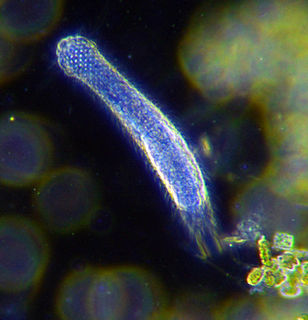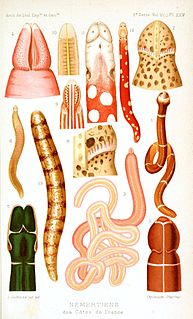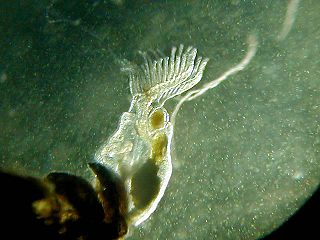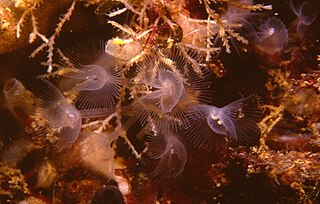Related Research Articles

Bryozoa are a phylum of aquatic invertebrate animals. Typically about 0.5 millimetres long, they are filter feeders that sieve food particles out of the water using a retractable lophophore, a "crown" of tentacles lined with cilia. Most marine species live in tropical waters, but a few occur in oceanic trenches, and others are found in polar waters. One class lives only in a variety of freshwater environments, and a few members of a mostly marine class prefer brackish water. 5869 living species are known. One genus is solitary and the rest are colonial.

The Sipuncula or Sipunculida is a group containing about 162 species of bilaterally symmetrical, unsegmented marine worms. The name Sipuncula is from the genus name Sipunculus, and comes from the Latin siphunculus meaning a "small tube". Sipuncula seems to be closely related to Myzostomida, and Annelida.

The Echiura, or spoon worms, are a small group of marine animals. Once treated as a separate phylum, they are now considered to belong to Annelida. Annelids typically have their bodies divided into segments, but echiurans have secondarily lost their segmentation. The majority of echiurans live in burrows in soft sediment in shallow water, but some live in rock crevices or under boulders, and there are also deep sea forms. More than 230 species have been described. Spoon worms are cylindrical, soft-bodied animals usually possessing a non-retractable proboscis which can be rolled into a scoop-shape to feed. In some species the proboscis is ribbon-like, longer than the trunk and may have a forked tip. Spoon worms vary in size from less than a centimetre in length to more than a metre.

The gastrotrichs, commonly referred to as hairybellies or hairybacks, are a group of microscopic (0.06-3.0 mm), worm-like, pseudocoelomate animals, and are widely distributed and abundant in freshwater and marine environments. They are mostly benthic and live within the periphyton, the layer of tiny organisms and detritus that is found on the seabed and the beds of other water bodies. The majority live on and between particles of sediment or on other submerged surfaces, but a few species are terrestrial and live on land in the film of water surrounding grains of soil. Gastrotrichs are divided into two orders, the Macrodasyida which are marine, and the Chaetonotida, some of which are marine and some freshwater. Nearly 800 species of gastrotrich have been described.

Nemertea is a phylum of invertebrate animals also known as ribbon worms or proboscis worms. Alternative names for the phylum have included Nemertini, Nemertinea and Rhynchocoela. Most are very slim, usually only a few millimeters wide, although a few have relatively short but wide bodies. Many have patterns of yellow, orange, red and green coloration. The foregut, stomach and intestine run a little below the midline of the body, the anus is at the tip of the tail, and the mouth is under the front. A little above the gut is the rhynchocoel, a cavity which mostly runs above the midline and ends a little short of the rear of the body. All species have a proboscis which lies in the rhynchocoel when inactive but everts to emerge just above the mouth and capture the animal's prey with venom. A highly extensible muscle in the back of the rhynchocoel pulls the proboscis in when an attack ends. A few species with stubby bodies filter feed and have suckers at the front and back ends, with which they attach to a host.

Entoprocta, whose name means "anus inside", or Kamptozoa, is a phylum of mostly sessile aquatic animals, ranging from 0.1 to 7 millimetres long. Mature individuals are goblet-shaped, on relatively long stalks. They have a "crown" of solid tentacles whose cilia generate water currents that draw food particles towards the mouth, and both the mouth and anus lie inside the "crown". The superficially similar Bryozoa (Ectoprocta) have the anus outside a "crown" of hollow tentacles. Most families of entoprocts are colonial, and all but 2 of the 150 species are marine. A few solitary species can move slowly.

The lophophore is a characteristic feeding organ possessed by four major groups of animals: the Brachiopoda, Bryozoa, Hyolitha, and Phoronida, which collectively constitute the protostome group Lophophorata. All lophophores are found in aquatic organisms.

Balanoglossus is an ocean-dwelling acorn worm (Enteropneusta) genus of great zoological interest because, being a Hemichordate, it is an "evolutionary link" between invertebrates and vertebrates. Balanoglossus is a deuterostome, and resembles the Ascidians or sea squirts, in that it possesses branchial openings, or "gill slits". It has notochord in the upper part of the body and has no nerve chord. It does have a stomochord, however, which is gut chord within the collar. Their heads may be as small as per 2.5 mm (1/10 in) or as large as 5 mm (1/5 in).

Phoronis is one of the two genera of the horseshoe worm family (Phoronidae), in the phylum Phoronida. The body has two sections, each with its own coelom. There is a specialist feeding structure, the lophophore, which is an extension of the wall of the coelom and is surrounded by tentacles. The gut is U-shaped. The diagnostic feature that distinguishes this genus is the lack of epidermal invagination at the base of the lophophore. These worms are filter feeders.

Phoronids are a small phylum of marine animals that filter-feed with a lophophore, and build upright tubes of chitin to support and protect their soft bodies. They live in most of the oceans and seas, including the Arctic Ocean but excluding the Antarctic Ocean, and between the intertidal zone and about 400 meters down. Most adult phoronids are 2 cm long and about 1.5 mm wide, although the largest are 50 cm long.

Brachiopods, phylum Brachiopoda, are a group of lophotrochozoan animals that have hard "valves" (shells) on the upper and lower surfaces, unlike the left and right arrangement in bivalve molluscs. Brachiopod valves are hinged at the rear end, while the front can be opened for feeding or closed for protection. Two major groups are recognized, articulate and inarticulate. The word "articulate" is used to describe the tooth-and-groove features of the valve-hinge which is present in the articulate group, and absent from the inarticulate group. This is the leading diagnostic feature (fossilizable), by which the two main groups can be readily distinguished. Articulate brachiopods have toothed hinges and simple opening and closing muscles, while inarticulate brachiopods have untoothed hinges and a more complex system of muscles used to keep the two valves aligned. In a typical brachiopod a stalk-like pedicle projects from an opening in one of the valves near the hinges, known as the pedicle valve, keeping the animal anchored to the seabed but clear of silt that would obstruct the opening.

Pseudunela cornuta is a species of minute sea slug, an acochlidian, a shell-less marine and temporarily brackish gastropod mollusk in the family Pseudunelidae. Adults are about 3 mm long and live in the spaces between sand grains.
Phascolopsis gouldii is a species of unsegmented benthic marine worm, also known as a peanut worm or star worm. It lives in burrows in muddy sand in shallow waters off North America.
Phoronopsis is a genus of horseshoe worm in the family Phoronidae, in the phylum Phoronida. The members of the genus live in tubes at the bottom of the sea.
Phoronopsis californica is a species of marine horseshoe worm in the phylum Phoronida. It was first described as a new species by William Hilton in 1930 when he found it at Balboa Bay in Newport Beach, California.
Listriolobus pelodes is a species of marine spoon worm. It is found in shallow seas in the North East Pacific off the coast of California. It lives in a burrow in soft sediments.

Phoronis australis is a species of marine horseshoe worm in the phylum Phoronida. It is found in shallow warm-temperate and tropical waters in the eastern Atlantic Ocean and the Indo-Pacific region and was first detected in the Mediterranean Sea in the late twentieth century. These worms live in association with tube-dwelling anemones, particularly those in the genus Cerianthus.
Phoronis ovalis is a species of marine horseshoe worm in the phylum Phoronida. It is found in shallow waters in the northeastern Atlantic Ocean, the southeastern Atlantic Ocean, Argentina, and other scattered locations worldwide. These worms secrete a tube into which they can retreat, and burrow into the shells of molluscs.
Nephasoma rimicola is a marine invertebrate belonging to the phylum Sipuncula, the peanut worms. This worm occurs in the northeastern Atlantic Ocean.
Thysanocardia procera is a marine invertebrate belonging to the phylum Sipuncula, the peanut worms. It is a cylindrical, unsegmented worm with a crown of tentacles around the mouth. It is native to shallow seas in the northeastern Atlantic Ocean.
References
- ↑ Cori, C.J. (1889). Beitrag zur Anatomie der Phoronis Inaug. Diss. Prag, 48 pp.
- ↑ World Register of Marine Species
- 1 2 3 4 Phoronida
- 1 2 3 4 "Invertebrate Anatomy OnLine". Archived from the original on 2011-08-01. Retrieved 2011-08-14.
- 1 2 Paleopolis: Phoronida